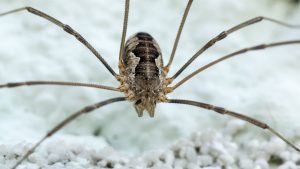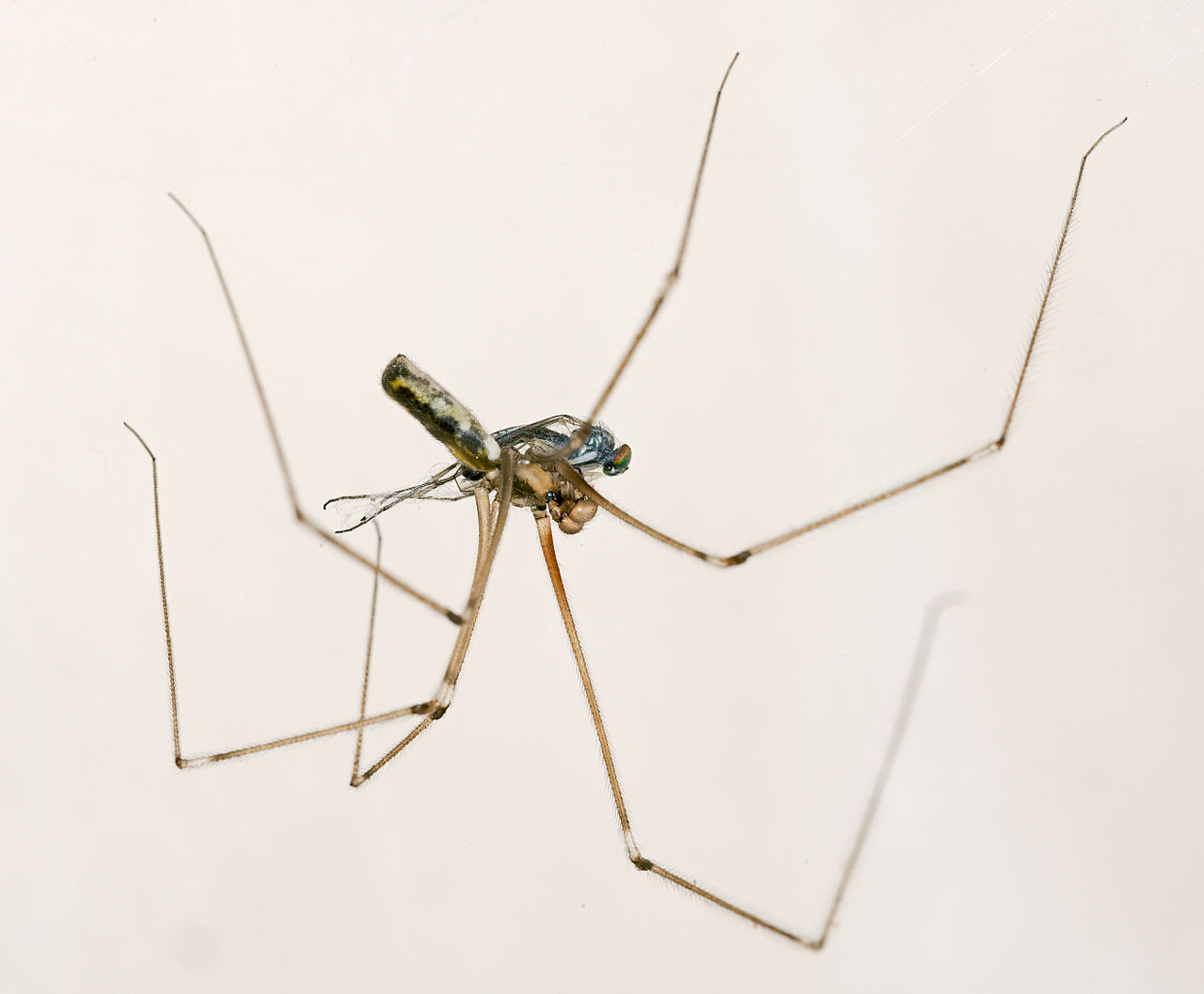Cellar Spiders: Tall Tales about an Itsy Bitsy Spider
In the depths of winter, many pest problems slow down – only those pests that are either cold-hardy enough to remain active in the snow or that can live their entire lives indoors are likely to be active in your home or business. One of these species that can live its whole life indoors gets some particularly negative press due to a bizarre myth that surrounds it. I would like to tackle that myth, but to make sure I don’t leave anything inaccurate in your mind, allow me to emphasize first that the animals I am about to discuss have never been documented harming humans… ever!
Without further ado, let’s consider the cellar spider (pictured at the top of this post. Photo credit – Didier Descouens). In some instances, these spiders can build large populations and contribute to the cobwebs that accumulate in crawlspaces, attics, cellars (hence the name), or other low-traffic and potentially high humidity areas, where their webs and droppings can create an unsightly mess. More often, you will find just one or a few of these gangly spiders hanging upside-down in a scant cobweb in a corner out of the way. Before I delve into the myth concerning these spiders, allow me to emphasize once again that they pose no threat to humans, though if you want tips for keeping them out of your home you may want to check out our other posts on spiders here and here.

The cellar spider is also known as the daddy long-legs spider. The “daddy long-legs” name is awfully confusing, because these spiders share it with harvestmen (figure 1), a non-venomous, non-silk-producing arachnid that is common under stones or logs and in dense brush outside, and with crane flies (Figure 2), a non-biting family of flies that look like giant mosquitoes. A pervasive myth claims that daddy long-legs is the most venomous spider in the world, but that its fangs are too small to bite you.
We should critique every part of the above statement: which “daddy longlegs” are we talking about? Is there any evidence that it has powerful venom? Is there evidence that its fangs cannot penetrate human skin? Considering that both harvestmen and crane flies are not venomous, not spiders, and lack fangs, it is probably safe to deduce that we are talking about cellar spiders here. So is there any truth to the claim that cellar spiders (a.k.a. daddy long-legs spiders) have powerful venom or that they have wimpy fangs? To my knowledge, there are no documented, confirmed cases of a cellar spider bite except one – on the show Mythbusters, a cellar spider was coerced to bite one of the show’s hosts, Adam Savage. He claimed to feel a short-lived, mild, localized burning sensation at the bite site. This suggests that if a cellar spider is forced to do so, it can penetrate human skin and inject venom. The venom causes symptoms that are comparable to the symptoms of many other spider bites – I have personally been bitten by a flower crab spider and by a barn orb weaver (e.g. Charlotte from Charlotte’s Web), and both caused a localized itchy, burning sensation for about 5-10 minutes that was comparable in severity to a particularly irksome mosquito bite. So there is limited evidence contrary to the myth, and prior to Mythbusters testing the myth, no known evidence at all.

So where did the myth come from? The origin is not entirely clear, but a leading suspicion posits that someone in Australia observed a cellar spider capture, kill, and eat a redback widow, which is comparably venomous to our black widows. The thinking was that if the cellar spider could dispatch a highly venomous widow spider, then it must be even more venomous itself, but the small fangs explained why nobody ever was stricken by a cellar spider bite. Many spiders are specially adapted to feed on other spiders. It is a risky lifestyle, because almost all spiders have sufficiently potent venom to kill any similar-sized spider with a single bite. With the bites themselves being a level playing field in spider-on-spider combat, other weapons that allow a spider to attack from a distance often play a bigger role: jumping spiders strum a web to lure a victim close then pounce like a jungle cat, assassin spiders spear other spiders with extra-long fangs, spitting spiders fire venomous silk out of their fangs, and cellar spiders use their incredibly long legs to bob and weave around a victim while throwing strands of silk until the prey is immobilized. Widow spiders actually use the same technique as cellar spiders, but with their fat, heavy abdomens and relatively shorter legs they’re slower and have to get in closer to wrap a victim in silk. Because they are more nimble and have a longer reach, cellar spiders have a potential advantage over widow spiders that has nothing to do with the potency of their venom.
At Guardian, we sometimes deal with spider infestations – their webbing can create a nuisance, and arachnophobia plus a spider infestation can be a miserable combination. If you have a spider problem, we can advise you on prevention and treatment of spider infestations. On the other hand, arming yourself with the knowledge that most spiders are harmless to anything substantially bigger than them may make those occasional spider singletons less traumatic, both for you and the spider.






